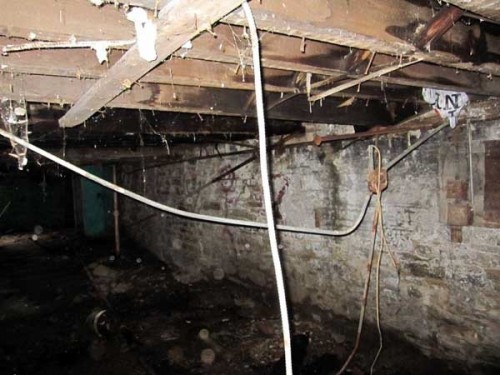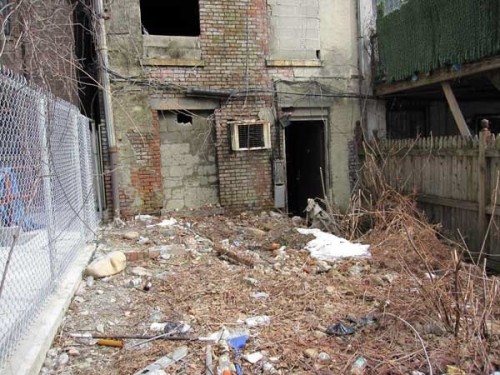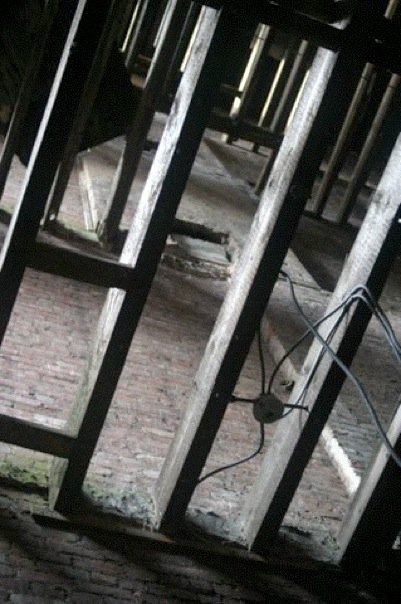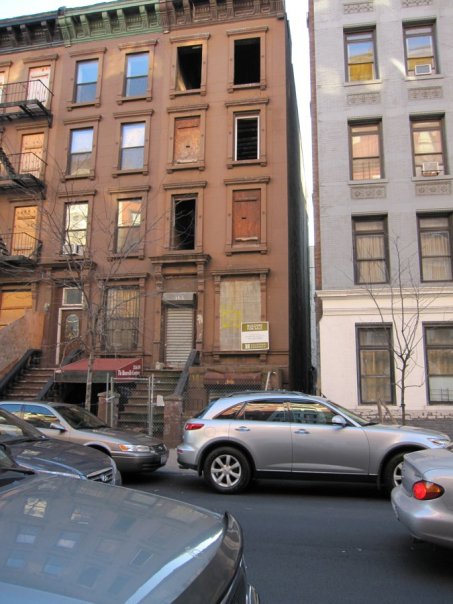Since now is the time to buy if you want a Harlem townhouse I thought I’d go over what some of the things are that you need to know before you buy a place. Being an “educated consumer” is critically important. A LOT of people have been financially devastated by Harlem townhouses – you don’t want to be one of them.
#1 – Realize Harlem Townhouses Are A Speculative Purchase
Harlem townhouses were built by speculators in the late 1800s and early 1900s in conjunction with the subways being extended north into Harlem. But then there was a real estate crash starting in 1904 and that speculation came to an end and rents dropped. Harlem townhouses started as speculative investments and 100 years later the cycle of speculation and failure is still going on as is evidenced by the fact that you can buy one for 1/3rd of it’s price 2-3 years ago.
You need to go into it knowing it’s a speculative purchase. While I firmly believe Harlem townhouses will fair far better in the next major downturn (10-20 years from now) there is no guarantee. Harlem is not Brownstone Brooklyn. It’s not “there” yet. It’s only starting to get things that people look for in “good” neighborhoods like great supermarkets and good schools.
There are certain implications to a speculative purchase. Namely you need to watch for the next real estate crash and either get out before it, or be prepared to weather it. If you go into it knowing that time will come, you won’t be so disappointed when it happens.
#2 – Be Very Careful Buying SROs
SROs are “single room occupancy” buildings where people have a room without a proper kitchen. I’ve been reading Sherlock Holmes lately and he lived in an SRO. At one time it was fashionable for single men to live in them – the landlord would serve them meals, etc. Then they just became the least expensive form of housing and the City’s poor gravitated to them. Today SRO tenants often earn $10,000 to $15,000 per year and typically pay 50% of their income to rent these cheapest of cheap rooms. The issue is that when you kick out an SRO tenant they often can’t find other housing and they become homeless.
As a result the City put a moratorium on converting SROs back in 1985 because there was a wave of landlords kicking out their poor tenants, converting to proper apartments and making a bunch of money. A year later they put in place a process whereby you can convert an SRO, but you have to prove that the tenants haven’t been harassed at any point in the past 3 years. To get the signatures required you often have to pay the tenants $10,000 or more, and then the City will take 6-9 months investigating your claim – making sure you didn’t omit anyone who lived in the building, etc. If they approve you, then you get a “certificate of no harassment” which enables you to get a building permit to do the conversion.
The bottom line is that you need to know whether the building you’re considering is an SRO, and if it is you should see a certificate of no harassment before going into contract. Even top brokers lie and tell half truths when they’re selling SROs that don’t have certificates of no harassment. So you need to know how to determine SRO status yourself. There are two primary sources – NYC Department of Buildings (DOB), and NYC Department of Housing Preservation and Development (HPD). HPD has a web site that tells you details about buildings. If the number of “B Units” is greater than zero, then it’s an SRO. Keep track of the Block and Lot numbers that HPD has and then head over to DOB’s BisWeb site. There you enter the block and lot numbers and you can see the information they have on the building. One of the pieces of information is whether the building is SRO restricted. Remember that if any City agency thinks the building is SRO restricted, then it’s SRO restricted, though DOB and HPD are the primary sources of information for SRO restrictions.
DO NOT BUY an SRO without a certificate of no harassment unless you really know what you’re doing.
There are a few cases where buying an SRO without a certificate of no harassment is OK…
First, is if you want to be an SRO landlord. It’s not easy, but it can be profitable. Fully occupied SROs go for $600-$800K. If you have a typical 4 story building with two units per floor, each giving you $650, then you’ve got a rent roll of $5,200. If you can get a mortgage that should more than cover the mortgage payments and expenses. HOWEVER, do watch the taxes – they can be really high on SROs and wipe out any profits. I saw one in East Harlem that paid $25K/year in taxes.
Second, it’s OK to buy an empty SRO if you’re OK with your renovations not being done for 5 years (3 years of waiting + 1 year of review + 1 year of construction). If you can get the current owner to provide a sworn statement that it’s been vacant that can reduce that time frame. You can live in it during that time but you’re only allowed to do “repairs and maintenance”. If you do anything to convert the building you can get fined for it and that violation can make it impossible for you to EVER convert the building. It can even make it difficult or impossible for the next owner to convert the building. In that case you may need to bring the building up to current code as an SRO first, clear the violation, and then reapply for the certificate. That means you pay for renovations twice.
#3 – Look For Realistic Sellers
There are a lot of townhouses on the market right now that are completely unrealistic about their price. Even the ones that have realistic owners typically price their places $200,000 higher than they know they’ll sell for. In our case it was listed for $795K and we purchased it for $530K. Pretty much the only ones that are realistic are estate sales. We got ours from TPE Townhouses Harlem (a part of Tahl Propp Equities). They bought 11 townhouses and didn’t develop them quickly enough and then needed to liquidate them when the market went south. So there are people other than estates who are realistic…
The only way to know if the seller is realistic is to put in a bid. We saw 30 places and put in bids on 7. In one case it was a realistic seller, but we pulled the bid after having second thoughts. In another case it was a short sale and they wanted all cash. The place on Astor Row was looking for people who were bidding based on their gut, not the numbers. In another case there was already an accepted bid and they went with that offer (we later learned that our offer was about $10K less). Given all the bids you’ll be putting in and how much you need the sellers to come down, it’s critical that you have a real estate broker who’s great at bidding aggressively. They need to pull out every trick in the book to get you the price you should pay. If you need a broker with excellent bidding skills, we’d highly recommend Maria McCallister of Barak Realty.
One assumption I made during our search was that eager sellers would list their properties with brokers who would market them aggressively. Right at the end I realized that wasn’t true. Back when the market was hot there were brokers who would get listings and then not market them because they didn’t want to share the commission. (Not every broker in NYC is part of REBNY, which requires co-broking.) Back when Harlem townhouses were so hot you couldn’t help but sell them, it wasn’t a bad strategy. But I had a friend who listed his place in 2008, before the crash, with one of those brokers. She got him into contract for $1.4M, but it fell through. Then the crash happened. A lot of time passed and she got him into contract again, but that one fell through as well. He finally sold the place earlier this year for $775K. By the end he was sorta desperate to sell and was bleeding financially. So those brokers do have motivated sellers and for one reason or another they manage to keep the listing. That particular broker was flat out lying to my friend. She told him she was advertising in the NY Times (she wasn’t). She said she listed his place in the REBNY systems, but our broker confirmed she wasn’t.
That means there is value scouring the web for small real estate companies that have some townhouse listings. Typically they don’t tell you the address or the price and are pretty obscure about other details as well. When you see the properties you need to do things differently. Start by seeing the place on your own and do not mention that you have a broker. Then bring your broker in later after you’ve started initial negotiations. When we wanted to see my friend’s place his broker pulled every trick in the book trying to not get us in before the contract with her buyer was signed. It was only when she realized I was standing there texting everything she did to my friend that she sorta stopped playing tricks.
#4 – The Block & Immediate Neighborhood Can Make A Huge Difference
Real estate values in Harlem vary widely from block to block. We didn’t understand why one townhouse down on 112th was asking so much until very late in the process when we realized how nice it was over in South Harlem (SoHa). Anything close to that goes for a premium. Up in Hamilton Heights you cross Amsterdam Ave and you can go from one of the best blocks anywhere in Harlem to blocks that are pretty sketchy. If you don’t already know Harlem, it can take some time to be able to discern the good areas from the bad.
Before you go into contract on a place go there at night when it’s nice weather and people are out on the street. It’s best to do it a few times to really get a feel for the place. Ask yourself whether you feel safe. If there’s loud music ask yourself how you’ll feel about that when you’re having guests over for a barbecue. Look for possible drug dealing. New York doesn’t really have a gang problem, but look for “rough” groups of kids who might hassle you. But don’t be too critical on that last point. We were going by one property and saw a group of kids outside a building. About 5 minutes as more and more of them arrived and they subsequently left we realized it was Friday night and they were just meeting up to go out clubbing. If they’re standing around laughing an joking chances are they won’t be a problem.
#5 – Get A Property Shark Membership With Comps
One of the best things you can do is get a membership to PropertyShark.com. You can get an incredible amount of information about each of the buildings. You can see tax information, ownership history, pictures, building permits, violations, lis pendens (pre-forclosures), etc.
One of the great things they have is comps search. Not sure what something is worth? Do a 1/4 mile radius search around the building for the past 6 months and you can see what comparable properties are actually selling for (not just their list prices). One trick is to search for all building types but limit the search by square footage. 6,000 or 6,500 square feet max should find the townhouses you’re looking for.
#6 – Realize It’s Usually All About $$/sq. ft.
It’s uncanny how townhouse sales are consistent in terms of price per square foot. HOWEVER, it’s not as easy as you think to calculate the cost per square foot because the DOB has used two different methods to calculate square footage over the years.
First a little terminology… A townhouse “basement” is the floor that’s partly below street level. It’s the “garden apartment” in many cases. Below that level is the “cellar”. Floors that are completely below grade are not included in the square footage of the building (and cannot be used for sleeping). The confusion has come with the basement level which is partly below grade.
When the buildings were first built the basement was used for the kitchen and a bedroom for the cook/maid. Since it wasn’t where the family lived it wasn’t included in the square footage of the building. But we use townhouses differently now and the basement is considered living space, so it is now included. Problem is, the DOB never went back and recalculated the square footages of buildings calculated the old way. That throws off the calculations of cost per square foot.
The important thing is to be consistent and compare apples to apples. How the square footage is calculated can make a big difference. Let’s say a building has 1,000 sq. ft. per floor and 4 stories including the basement. That means it’s either 3,000 or 4,000 sq. ft. Now, if it sold for $1M then the cost per square foot was either $333 or $250 – a HUGE difference. So you have to be consistent one way or the other. On Property Shark you can see the building’s dimensions and whether it has an extension on the back. If there isn’t an extension then it’s easy to calculate. However sometimes the extension is included in the length of the building and sometimes it isn’t. So there are times when you just can’t tell. If you see a C of O in the past 10 years or so, then you can trust the official square footage of the building and know that it includes the basement.
One other thing to remember is that, unlike apartments, townhouse square footage includes the exterior walls. A considerable amount of the square footage can be walls. For example our place has an exterior dimension of 15′ x 58′ or 870 sq. ft. per floor. The brick walls are about 1′ thick. We share one wall with the townhouse next to us, so brick to brick our square footage is 13.5′ x 56′ or 756 sq. ft. If we did 4 inch studs on all exterior walls that would reduce things further to 12.8′ x 55.3′ or 708 sq. ft. That’s a huge difference from 870 sq. ft – nearly 20% of our square footage is exterior walls.
As you get to know the market you’ll understand the value of buildings and a quick calculation can give you an approximate price. “Why are you asking $400/sq. ft. for a building in poor condition?” can be a fun thing to ask the listing broker… 😉
And one side note – since it is all about price per square foot – if you’re tempted to put in double height ceilings when you do your renovations remember that you’ll be reducing your square footage and devaluing your property.
#7 – Know How Much Renovation Costs
Most of the townhouses in Harlem have 100 year old plumbing and nearly as old electrical systems. Very few of them are properly insulated. Most have rotten floor joists under the bathrooms. That means they all need major work. Never assume otherwise. And replacing things like plumbing, electrical and insulation in an old building requires skilled workers who are able to do their work surgically. Assume plumbing and electric will cost you $150K. If you buy a total shell like ours you’ll be spending at least $150K, probably $200K, just on new structural components. Windows can run you $1K/window for good windows (Harlem townhouses have some HUGE windows – we have one that’s 4 1/2′ x 7 1/2′ and others that are 3 1/2′ x 9′ – the place on Astor Row has a window that’s 5′ x 7′ and on a landmarked exterior where you’re required to use relatively expensive windows).
Then there’s the new building code… In 2008 the City implemented a new building code. The prior building code was from 1968. They didn’t change that much but what they did change can be expensive. For starters more buildings need sprinkler systems – that will run you at least $50K since sprinkler systems have to be done with cast iron pipes that won’t melt in a fire. You’ll also need at least one “handicap adaptable” bathroom per unit. If you’re thinking about an elevator, the minimum size just got a lot bigger. If you’re trying to change your C of O (e.g. converting an SRO) you have to bring it up to code – so all of that may be necessary…
In general, townhouses that look like they’re in pretty good shape will probably need at least $250K in renovation just for new electrical, plumbing, bathrooms and kitchens (though you may be able to defer that cost for a few years). For bigger projects you need to budget $150-200/sq. ft. for a pretty basic job. High end finishes will run you even more. That means a townhouse in poor condition with 4,000 sq. ft. can easily have a renovation that costs $800K. You can do it for less, but you really have to work hard to find a reputable contractor who can do things inexpensively and then you have to scrutinize every line item on the budget and spend countless hours learning about the options for every major system in the building.
And don’t forget all the little costs – the architect will want about 10% of the construction cost. Then you’ll need to budget money to carry the renovation loan during construction. Just those two can easily be $100,000 or more.
Before you bid on a place, conservatively estimate the future value after renovations and then deduct over-estimated renovation costs. The purchase price + renovations should be less than the future value. If it’s not, lower your bid.
Good luck!






